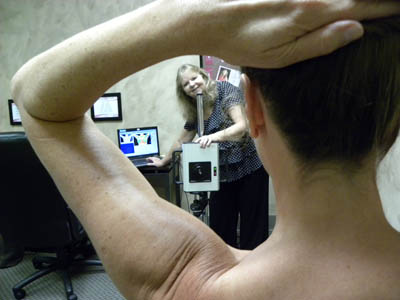
Are you concerned about your breast health? Does breast cancer run in your family? Are mammograms too painful to do regularly? There’s another, relatively new, screening tool for early disease prevention and detection—thermography. It is a 15-minute, non-invasive test of physiological changes that accompany breast pathology, whether it is cancer, fibrocystic disease, infection, or vascular disease. It’s basically infrared images showing the variation in temperature in your body, which indicates normal versus inflamed tissue.
Many of us have small, dense, or fibrous breasts, which make mammograms extremely painful and can make problems difficult to detect. After years of dreading mammograms, putting them off, even avoiding them entirely, I began searching for an additional way to monitor my breast health. I was thrilled to discover thermography, as it is painless, uses no radiation or compression, detects issues very early, and can detect issues in other parts of the body as well.
“Thermography can detect signs of problems up to 10 years sooner than mammography, thus giving the patient an opportunity to implement corrective lifestyle changes. Diet, supplements, specific exercises, natural hormone balancing, and detoxification can help address inflammation, thus often preventing these problems from developing into something more serious,” says Libby Ray, certified clinical thermographer. “This screening allows patients to be proactive, rather than just reactive. It gives them the opportunity to take charge of their health in a preventative manner.”
 …thermography is not meant to replace mammography altogether…it’s one of the best prescreening modalities out there today, especially for younger women with denser breast tissue, women with fibrous breast tissue, as well as those with breast implants or mastectomies.
…thermography is not meant to replace mammography altogether…it’s one of the best prescreening modalities out there today, especially for younger women with denser breast tissue, women with fibrous breast tissue, as well as those with breast implants or mastectomies.
Libby has been involved with BRAS, Breast Research Awareness and Support, since Linda Bamber founded it in 2008. She has an office at 1358 E. Kingsley, Suite C, in Springfield, Missouri and is listed as an approved clinic with the Amercian College of Clinical Thermology. You can reach her at 417-894-5222 or at brasthermography.com. DITI has been recognized as a viable diagnostic tool since 1987 by the American Medical Association’s Council on Science and Public Health, the American Chiropractic Association’s Council on Diagnostic Imaging, the Congress of Neurological Surgeons in 1988, and in 1990 by the Academy of Physical Medicine and Rehabilitation.
While thermography had me at “painless,” I am even more convinced after speaking with Libby that it’s my first tool for breast screening, in addition to self-examination. I am all about prevention, as I prefer not to rely on medicines or surgeries to stay healthy, and I am a huge believer in alternative methods for getting and staying healthy. But this is a very individual choice. If you Google both thermography and mammography, you’ll find plenty of pros and cons for each. So you have to decide what is best for yourself.
When asked about thermography as opposed to mammography, Libby warns that thermography is not meant to replace mammography altogether. She emphasizes that it’s one of the best prescreening modalities out there today, especially for younger women with denser breast tissue, women with fibrous breast tissue, as well as those with breast implants or mastectomies. Yet, if a problem is detected and shows no improvement, or worsens in 3-6 months, then all modalities should be employed, including mammography and ultrasound, to monitor that problem. And, of course, self-examinations should always be included in women’s breast health routine.
“There are so many different things in our bodies and lives that affect our breast health,” Libby explains, “besides the things we hear about regularly, like family history (or genetics). Thyroid health, the lymphatic system, dental health, and diet are among those many things that affect our breasts. And thermography can easily identify problems such as stagnation, sluggishness, or blockage in the thyroid, lymph nodes, and dental and sinus cavities, for instance, long before they become a serious problem affecting the breasts.”
In addition to regular dental checkups to make sure our teeth and gums stay healthy, Libby mentioned many other things we can do preventatively to ensure our breast health, including not wearing a tight fitting bra all day, eliminating aluminum from our deodorants, limiting the amount of radiation we are exposed to, getting enough iodine in our bodies (and the iodine in Morton’s salt is not enough and not of the best quality—there are creams women can use that are easy and effective), and eating a breast health supporting diet.
Besides breast screening, thermography can also be used as an aid for diagnosis and prognosis, as well as monitoring therapy progress for conditions and injuries, including: back injuries, arthritis, headache, nerve damage, unexplained pain, fibromyalgia, RSD (CRPS), dental and TMJ conditions, artery inflammation, vascular disease, carpal tunnel syndrome, disc disease, inflammatory pain, skin cancer, referred pain syndrome, sprain/strain, stroke screening, whiplash, and digestive disorders.
I have had appointments in two different locations, both, unfortunately, out of state as there are no locations in Arkansas. Both were so easy and pleasant, it felt more like going to get a manicure than going to a doctor’s office! And I love how thorough a consultation with a BRAS clinician is. Each experience went generally like this:
• I arrived in a cozy, quiet office and was greeted by the clinician who immediately made me feel comfortable and at ease.
• First, we discussed my medical questionnaire (which I filled out via email before my appointment) and addressed my concerns and questions.
• Then she explained that the process is completely non-invasive, that nothing even touches my body, and it will be just the two of us.
• She left me to remove my top and bra and sit for 10-15 minutes in the slightly chilly screening room so I could cool down, making any inflammation in my body easier for the imaging to detect.
• I then sat on a stool about eight feet from the imaging equipment while she guided me through several positions while taking the images. I got just my upper body done, which includes from the face to the diaphragm. It took only 10, maybe 15, minutes to capture all the images.
• The results are instantaneous. We discussed several areas that indicated some inflammation, and she suggested I may be getting a bit of a sinus cold, that my neck may need adjustment, and that the lymph drainage in my armpits was a little congested—all easy things to work on.
• I got dressed and we were done. The entire visit usually takes less than half an hour. Easy peasy!
Though the clinicians are skilled at seeing inflammation in the images and will discuss diet and lifestyle changes they feel may be beneficial, as in my case, they leave the clinical diagnosis to the certified medical doctors trained in reading thermal images. All of the results can be mailed or emailed to you within a few days and you can share them with your general practitioner, who may or may not be open to using the results. Typically, you have your first thermography to establish a base line, with a followup in 3 months, and further followups determined by the results. If the screening results of your breasts in those first two visits are normal, as mine were, then annual exams from there on out are recommended.
While I found both clinicians to be wonderful, Libby Ray has the closest office I could find in our area and she’s fantastic! I was very impressed with her extensive knowledge and evident passion for helping clients get involved in their own health and wellness. She is extremely easy to talk to and I never felt rushed, or like a number in a line. The experience was relaxed, informative, private, and personal.
If you are as excited as I am about this relatively new, radiation free, compression free, non-invasive screening tool for early intervention for your breast and body health, then please look into it. Following is the information to schedule an appointment with Libby. From the website you can follow links to more information about thermography and all the BRAS locations in the country. You can go to Libby’s office for yourself or get a group of 8-10 women together and Libby will bring her equipment to you! M! October/November 2015

Leave a Reply